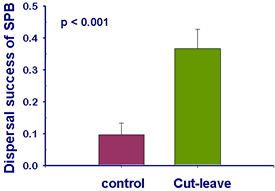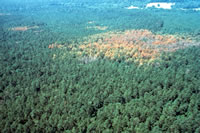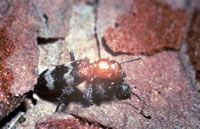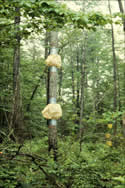Southern Pine Beetle Spatial Dynamics and Control
During the early 1990s, while I was a postdoc at the Southern Research Station (USDA-Forest Service in Pineville, LA), I studied the management and population dynamics of a pernicious pest of southeastern pine forests, the southern pine beetle (SPB, Dendroctonus frontalis). I was involved in three projects:
1. Area-wide management of the SPB
There are few experimental studies that have examined the movement of forest pest populations, particularly in response to management tactics that disrupt the growth of pest infestations. In this study (Cronin et al. 1999), intra- and inter-infestation patterns of SPB dispersal were quantified by monitoring the fates of fluorescently-marked beetles following emergence from small natural infestations. Dispersal patterns from untreated infestations were compared to those from infestations treated with the widely used disruption suppression tactic, cut-and-leave. We found that, relative to control infestations, beetles in the cut-and-leave treatment were four times more likely to disperse to new infestations (experimentally created) in the surrounding forest. This suppression tactic clearly alters the dispersal patterns of the beetles and encourages increased beetle activity in the surrounding region. We suggested that effective control of mobile pests may be only possible by expanding our spatial scope and seeking to maximize the area-wide, not local, efficacy of management tactics.


2. Spatial pattern formation of the SPB.
An interesting phenomenon occurs with the SPB: spatially discrete infestations (i.e., spots) arise in relatively homogeneous forest habitat. Peter Turchin, John Reeve (both former scientists at the Southern Research Station), and I became intrigued with the underlying cause for spatial pattern formation in this pest species. Turchin’s earlier work indicated that the SPBs patterns of movement were well described by a reaction-diffusion process. This type of movement would, of itself, result in the uniform distribution of pine beetles. John Reeve and I subsequently determined that one of the primary predators of the SPB, the checkered beetle Thanasimus dubius , exhibits rates of diffusion that are both heterogeneous (possibly owing to a combination of fast and slow dispersers) and faster than the rates found in the pine beetle (Cronin et al. 2000). We hypothesized that the inequities in the dispersal capabilities of the predator and prey, coupled with a strong Allee effect in the SPB, and the underaggregation of checkered beetles to SPB infestations generates diffusive instabilities and causes spatial patterning of SPB populations. This was addressed in Cronin et al. (2000) and in a model by Turchin et al. (1998).

3. Fungal interactions affect SPB population dynamics.
In collaboration with scientists at Dartmouth University and the Southern Research Station (Hofstetter et al. 2006), we have examined the effects of two linked mutualisms on the population dynamics of the SPB. One mutualism involves an obligate association between the SPB and its mycangial fungi. The second mutualism involves Tarsonemus mites that are phoretic on SPB and a blue-staining fungus, Ophiostoma minus. Surveys of SPB populations suggested that high abundances of Tarsonemus and O. minus were strongly correlated with the decline and eventual extinction of beetle populations. Factorial manipulation of SPB and O. minus density in field cages revealed strong negative effects of O. minus on beetle larvae. Tarsonemus and O. minus appeared to exert their effects on beetles independently of beetle density. The strong mutualism between Tarsonemus and O. minus likely contributes to the evolutionary maintenance of the antagonism between O. minus and the SPB. Co-occurrence of mutualisms embedded within a community may have stabilizing effects if both mutualisms limit each other. However, delays and/or non-linearities in the interaction systems may result in large population fluctuations, such as those displayed by SPB.

Although I am no longer actively working on the SPB study system, I would be interested in supporting graduate student research in this area.









